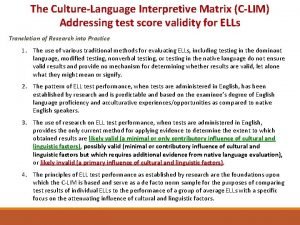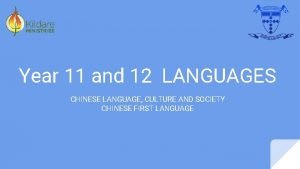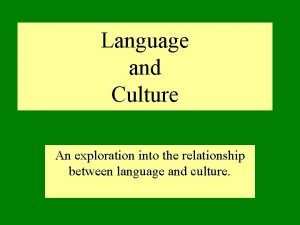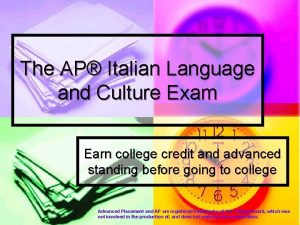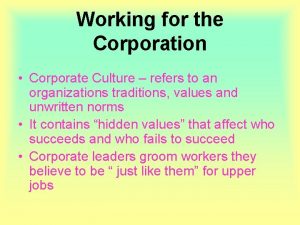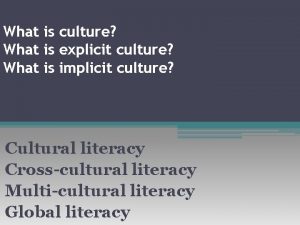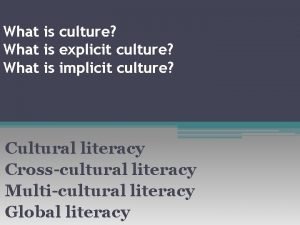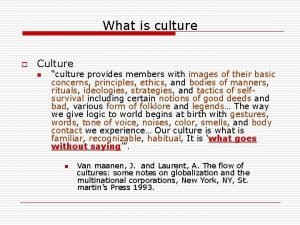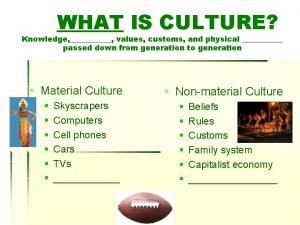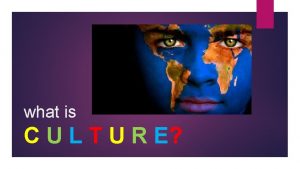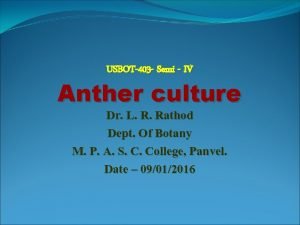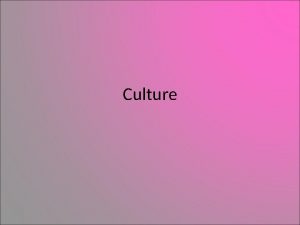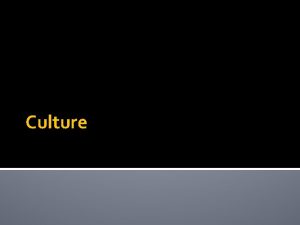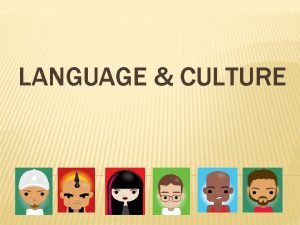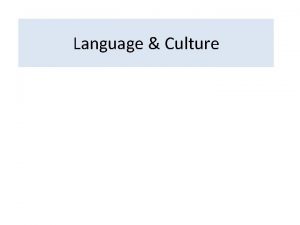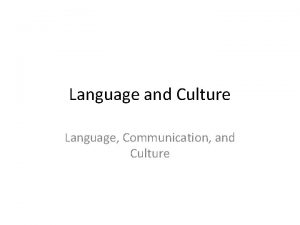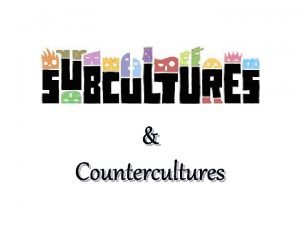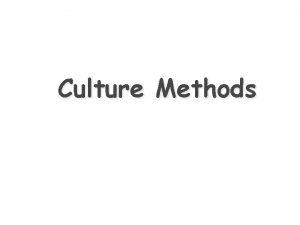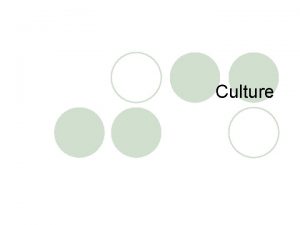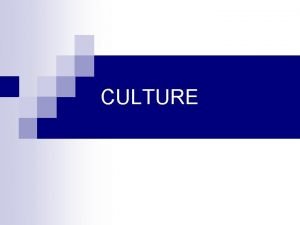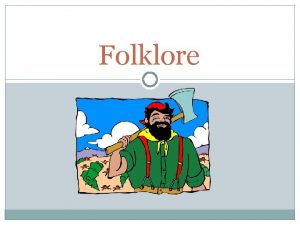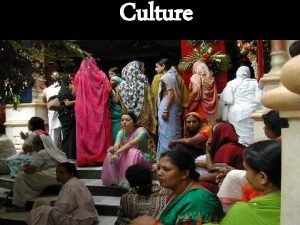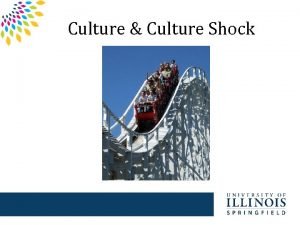LANGUAGE Language Culture n n Language is a































- Slides: 31

LANGUAGE

Language & Culture n n Language is a set of sounds and symbols that is used for communication. Language is an integral part of culture. Language reflects where a culture has been and what it values. Language makes people in a culture visible to each other and to the world.

Language Terms • Monolingual states are countries where almost everyone speaks the same language. Ex. : Japan, Uruguay, Iceland, Denmark, Portugal, Poland, Lesotho • Countries in which more than one language is in use are called multilingual states.

Signs in Barcelona, Spain Signs in Barcelona are written both in Catalán (top) and Spanish (bottom).

Official Languages n n n Countries with linguistic fragmentation often adopt an official language (or languages) to tie the people together. A State adopts an official language in the hope of promoting communication and interaction among peoples who speak different local and regional languages. The official languages in a country are a reflection of the country’s history.

Global Languages n n The principal language people use around the world in their day-to-day activities A common language of trade and commerce used around the world A lingua franca is a language used among speakers of different languages for the purposes of trade and commerce. Can be a single language or a mixture of two or more languages.

n n Pidgin language: When people speaking two or more languages are in contact and they combine parts of their languages in a simplified structure and vocabulary. Creole language is a pidgin language with a more complex structure and vocabulary that has become the native language of a group of people.

Port-au-Prince, Haitian Creole and French are both official languages in Haiti, although English is also used.

Language Families of the World Fig. 5 -11: Distribution of the world’s main language families. Languages with more than 50 million speakers are named.

Major Language Families Percentage of World Population Fig. 5 -11 a: The percentage of world population speaking each of the main language families. Indo-European and Sino-Tibetan together represent almost 75% of the world’s people.

Language Family Trees Fig. 5 -12: Family trees and estimated numbers of speakers for the main world language families.

Language Diffusion • Language divergence - where new language forms from old one. • Language convergence - collapsing two languages into one. • Linguists theorize that the hearth of the Proto-Indo-European language was somewhere in the vicinity of the Black Sea or east-central Europe.

Dialects • Variants of a standard language along regional or ethnic lines • Differences in vocabulary, syntax, pronunciation, cadence, and pace of speech • Dialects frequently marked by actual differences in vocabulary


Indo-European Language Family Fig. 5 -5: The main branches of the Indo-European language family include Germanic, Romance, Balto-Slavic, and Indo-Iranian.

The Indo-European Language Family n Branches of Indo-European n n Germanic branch Indo-Iranian branch Balto-Slavic branch Romance branch

Germanic Branch of Indo-European Fig. 5 -6: The Germanic branch today is divided into North and West Germanic groups. English is in the West Germanic group.

Invasions of England 5 th - 11 th centuries Fig. 5 -2: The groups that brought what became English to England included Jutes, Angles, Saxons, and Vikings. The Normans later brought French vocabulary to English.

English Speaking Countries Fig. 5 -1: English is an official language in 50 countries, including some in which it is not the most widely spoken language. It is also used and understood in many others. English Mania

Romance Branch of Indo-European Fig. 5 -8: The Romance branch includes three of the world’s 12 most widely spoken languages (Spanish, French, and Portuguese), as well as a number of smaller languages and dialects.

Russian Sign Russian is an Indo-European language written in the Cyrillic alphabet, originally brought to Russia by Greek missionaries

South Asian Languages & Language Families Fig. 5 -7: Indo-European is the largest of four main language families in South Asia. The country of India has 18 official languages.

Language Families of Africa Fig. 5 -14: The 1000 or more languages of Africa are divided among five main language families, including Austronesian languages in Madagascar.

Languages of Nigeria Fig. 5 -15: More than 500 languages are spoken in Nigeria, the largest country in Africa (by population). English, considered neutral, is the official language.

Language Issues n n Language is so closely tied to culture that people use language as a weapon in cultural conflict and political strife. Preserving language diversity n n n Hebrew: reviving extinct languages Celtic: preserving endangered languages Global dominance of English n n English as a lingua franca Diffusion to other languages

Language Divisions in Belgium Fig. 5 -16: There has been much tension in Belgium between Flemings, who live in the north and speak Flemish, a Dutch dialect, and Walloons, who live in the south and speak French.

Bookstore in Brussels, Belgium The name of the bookstore is printed in both French (top) and Flemish (bottom).

Language Areas in Switzerland Fig. 5 -17: Switzerland remains peaceful with four official languages and a decentralized government structure.

French-English Boundary in Canada Fig. 5 -18: Although Canada is bilingual, French speakers are concentrated in the province of Quebec, where 80% of the population speaks French.

1995 Quebec for Secession The immigrant vote was a significant factor in preventing Quebec’s secession from Canada.

French Signs in Québec City Reclaiming the cultural landscape was seen as a victory for French Canadians.
 Examples of popular culture
Examples of popular culture Individual culture traits combine to form culture patterns.
Individual culture traits combine to form culture patterns. Batch culture vs continuous culture
Batch culture vs continuous culture Batch culture vs continuous culture
Batch culture vs continuous culture Collectivistic cultures
Collectivistic cultures Indian culture vs american culture
Indian culture vs american culture Stroke culture method
Stroke culture method Folk culture and popular culture venn diagram
Folk culture and popular culture venn diagram Sub culture group
Sub culture group Folk culture and popular culture venn diagram
Folk culture and popular culture venn diagram Composite media in microbiology
Composite media in microbiology Homework due today
Homework due today Inert organizational culture
Inert organizational culture Anaerobic culture method
Anaerobic culture method Lawn or carpet culture
Lawn or carpet culture Quality culture changing hearts minds and attitudes
Quality culture changing hearts minds and attitudes Surface culture deep culture and esol
Surface culture deep culture and esol Culture-language interpretive matrix (c-lim)
Culture-language interpretive matrix (c-lim) Patrician high school
Patrician high school Language culture and curriculum
Language culture and curriculum Language in life
Language in life Relationship between language and culture
Relationship between language and culture Relationship between language and culture
Relationship between language and culture Ap italian language and culture
Ap italian language and culture The term corporate culture refers to
The term corporate culture refers to Explicit culture is
Explicit culture is What is explicit culture
What is explicit culture Culture n
Culture n What is real culture
What is real culture Culture definition
Culture definition Deep culture examples
Deep culture examples Anther culture
Anther culture

















